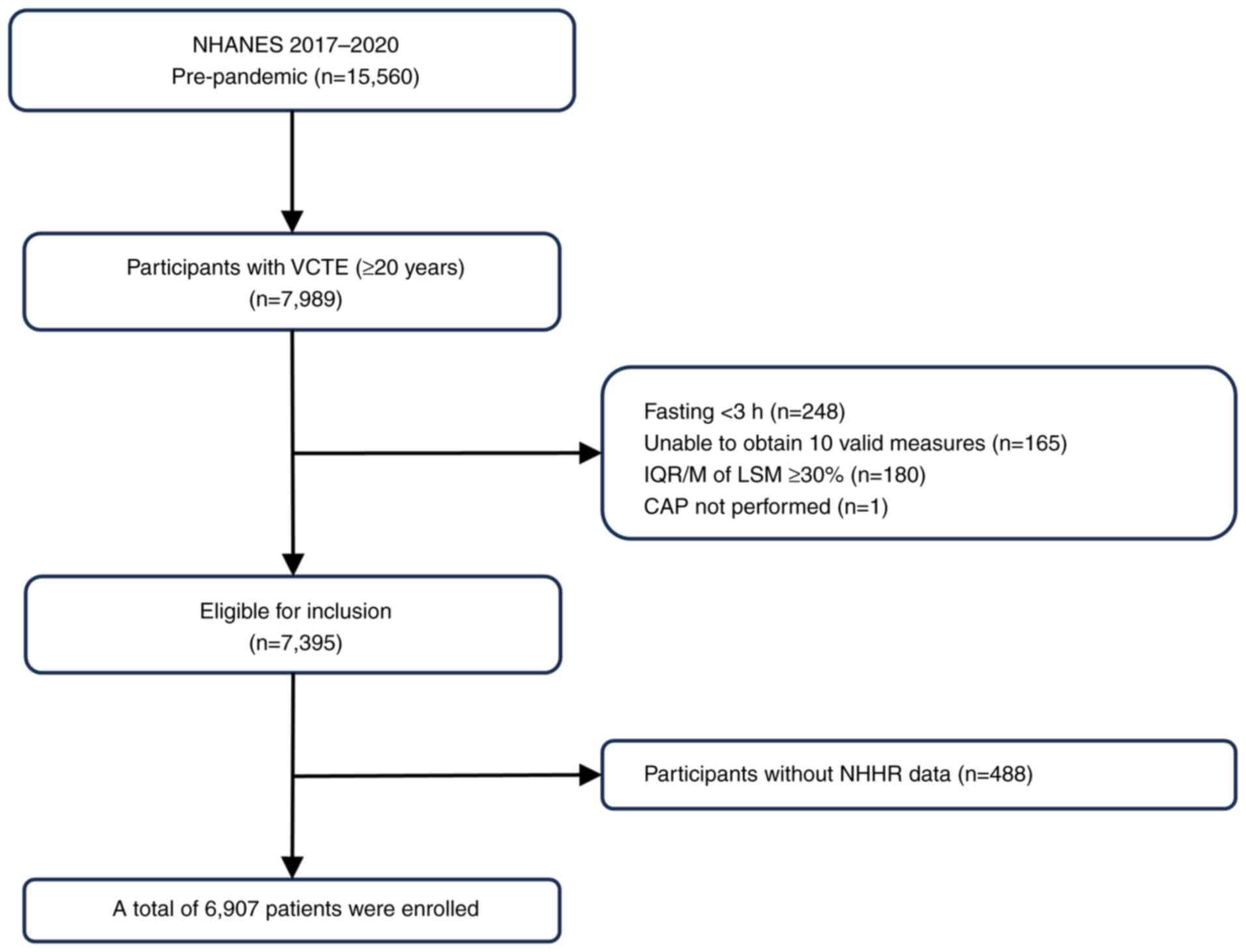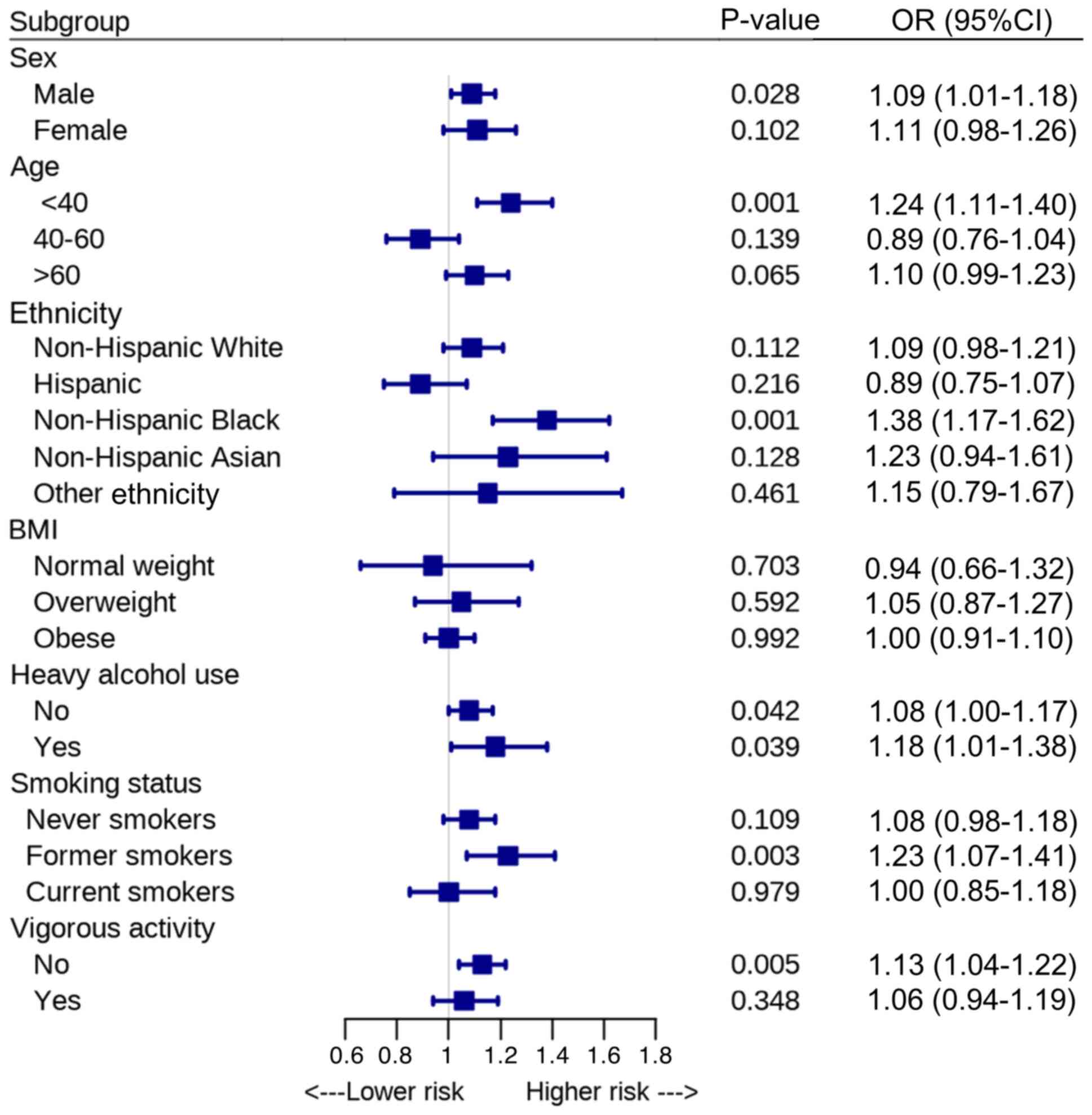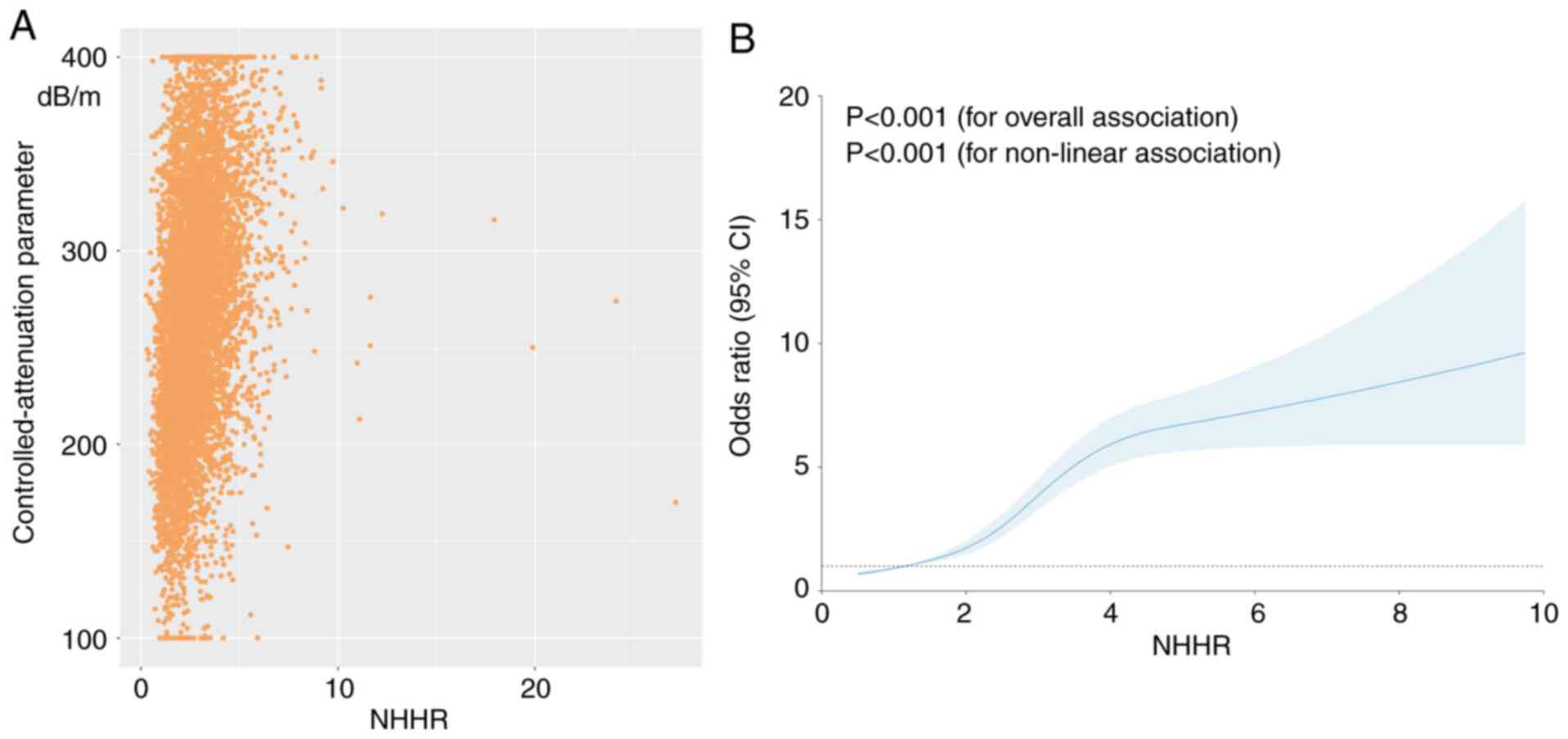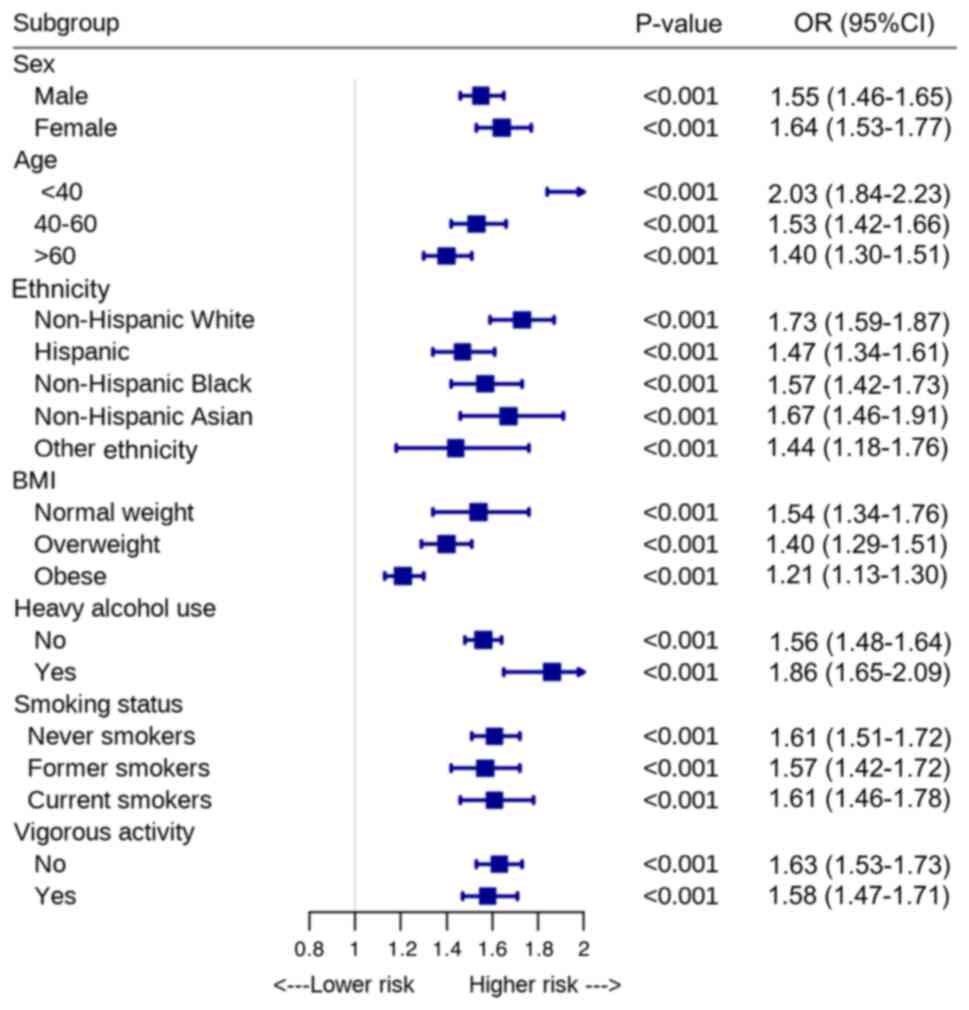|
1
|
Estes C, Razavi H, Loomba R, Younossi Z
and Sanyal AJ: Modeling the epidemic of nonalcoholic fatty liver
disease demonstrates an exponential increase in burden of disease.
Hepatology. 67:123–133. 2018.PubMed/NCBI View Article : Google Scholar
|
|
2
|
Le P, Chaitoff A, Rothberg MB, McCullough
A, Gupta NM and Alkhouri N: Population-based trends in prevalence
of nonalcoholic fatty liver disease in US adults with type 2
diabetes. Clin Gastroenterol Hepatol. 17:2377–2378. 2019.PubMed/NCBI View Article : Google Scholar
|
|
3
|
European Association for the Study of the
Liver (EASL); European Association for the Study of Diabetes
(EASD); European Association for the Study of Obesity (EASO).
EASL-EASD-EASO clinical practice guidelines on the management of
metabolic dysfunction-associated steatotic liver disease (MASLD). J
Hepatol. 81:492–542. 2024.PubMed/NCBI View Article : Google Scholar
|
|
4
|
Rinella ME, Neuschwander-Tetri BA,
Siddiqui MS, Abdelmalek MF, Caldwell S, Barb D, Kleiner DE and
Loomba R: AASLD practice guidance on the clinical assessment and
management of nonalcoholic fatty liver disease. Hepatology.
77:1797–1835. 2023.PubMed/NCBI View Article : Google Scholar
|
|
5
|
European Association for the Study of the
Liver; Clinical Practice Guideline Panel; Chair:; EASL Governing
Board representative:; Panel members. EASL clinical practice
guidelines on non-invasive tests for evaluation of liver disease
severity and prognosis-2021 update. J Hepatol. 75:659–689.
2021.PubMed/NCBI View Article : Google Scholar
|
|
6
|
Eddowes PJ, Sasso M, Allison M, Tsochatzis
E, Anstee QM, Sheridan D, Guha IN, Cobbold JF, Deeks JJ, Paradis V,
et al: Accuracy of fibroscan controlled attenuation parameter and
liver stiffness measurement in assessing steatosis and fibrosis in
patients with nonalcoholic fatty liver disease. Gastroenterology.
156:1717–1730. 2019.PubMed/NCBI View Article : Google Scholar
|
|
7
|
Vilar-Gomez E, Vuppalanchi R, Gawrieh S,
Samala N and Chalasani N: CAP and LSM as determined by VCTE are
independent predictors of all-cause mortality in the US adult
population. Hepatology. 77:1241–1252. 2023.PubMed/NCBI View Article : Google Scholar
|
|
8
|
Yu H, Huang Y, Li M, Jiang H, Yang B, Xi
X, Smayi A, Wu B and Yang Y: Prognostic significance of dynamic
changes in liver stiffness measurement in patients with chronic
hepatitis B and compensated advanced chronic liver disease. J
Gastroenterol Hepatol. 39:2169–2181. 2024.PubMed/NCBI View Article : Google Scholar
|
|
9
|
Hong H, He Y, Gong Z, Feng J and Qu Y: The
association between non-high-density lipoprotein cholesterol to
high-density lipoprotein cholesterol ratio (NHHR) and kidney
stones: A cross-sectional study. Lipids Health Dis.
23(102)2024.PubMed/NCBI View Article : Google Scholar
|
|
10
|
Lin W, Luo S, Li W, Liu J, Zhou T, Yang F,
Zhou D, Liu Y, Huang W, Feng Y and Luo J: Association between the
non-HDL-cholesterol to HDL- cholesterol ratio and abdominal aortic
aneurysm from a Chinese screening program. Lipids Health Dis.
22(187)2023.PubMed/NCBI View Article : Google Scholar
|
|
11
|
Tan MY, Weng L, Yang ZH, Zhu SX, Wu S and
Su JH: The association between non-high-density lipoprotein
cholesterol to high-density lipoprotein cholesterol ratio with type
2 diabetes mellitus: Recent findings from NHANES 2007-2018. Lipids
Health Dis. 23(151)2024.PubMed/NCBI View Article : Google Scholar
|
|
12
|
Hou K, Song W, He J and Ma Z: The
association between non-high-density lipoprotein cholesterol to
high-density lipoprotein cholesterol ratio (NHHR) and prevalence of
periodontitis among US adults: A cross-sectional NHANES study. Sci
Rep. 14(5558)2024.PubMed/NCBI View Article : Google Scholar
|
|
13
|
Qi X, Wang S, Huang Q, Chen X, Qiu L,
Ouyang K and Chen Y: The association between non-high-density
lipoprotein cholesterol to high-density lipoprotein cholesterol
ratio (NHHR) and risk of depression among US adults: A
cross-sectional NHANES study. J Affect Disord. 344:451–457.
2024.PubMed/NCBI View Article : Google Scholar
|
|
14
|
Yang S, Zhong J, Ye M, Miao L, Lu G, Xu C,
Xue Z and Zhou X: Association between the non-HDL-cholesterol to
HDL-cholesterol ratio and non-alcoholic fatty liver disease in
Chinese children and adolescents: A large single-center
cross-sectional study. Lipids Health Dis. 19(242)2020.PubMed/NCBI View Article : Google Scholar
|
|
15
|
Ciardullo S and Perseghin G: Statin use is
associated with lower prevalence of advanced liver fibrosis in
patients with type 2 diabetes. Metabolism.
121(154752)2021.PubMed/NCBI View Article : Google Scholar
|
|
16
|
Vilar-Gomez E, Nephew LD, Vuppalanchi R,
Gawrieh S, Mladenovic A, Pike F, Samala N and Chalasani N:
High-quality diet, physical activity, and college education are
associated with low risk of NAFLD among the US population.
Hepatology. 75:1491–1506. 2022.PubMed/NCBI View Article : Google Scholar
|
|
17
|
Yu H, Li M, Yang B, Sun H, Jiang H, Liang
Z, Smayi A, Wu B and Yang Y: Proton pump inhibitor use is
associated with increased liver steatosis. Biomed Rep.
21(116)2024.PubMed/NCBI View Article : Google Scholar
|
|
18
|
Leung CW and Tapper EB: Sugar-sweetened
beverages are associated with increased liver stiffness and
steatosis among apparently healthy adults in the United States.
Clin Gastroenterol Hepatol. 20:959–961.e1. 2022.PubMed/NCBI View Article : Google Scholar
|
|
19
|
Ruan Z, Lu T, Chen Y, Yuan M, Yu H, Liu R
and Xie X: Association between psoriasis and nonalcoholic fatty
liver disease among outpatient US adults. JAMA Dermatol.
158:745–753. 2022.PubMed/NCBI View Article : Google Scholar
|
|
20
|
Siddiqui MS, Vuppalanchi R, Van Natta ML,
Hallinan E, Kowdley KV, Abdelmalek M, Neuschwander-Tetri BA, Loomba
R, Dasarathy S, Brandman D, et al: Vibration-Controlled transient
elastography to assess fibrosis and steatosis in patients with
nonalcoholic fatty liver disease. Clin Gastroenterol Hepatol.
17:156–163.e2. 2019.PubMed/NCBI View Article : Google Scholar
|
|
21
|
Rinella ME, Lazarus JV, Ratziu V, Francque
SM, Sanyal AJ, Kanwal F, Romero D, Abdelmalek MF, Anstee QM, Arab
JP, et al: A multisociety Delphi consensus statement on new fatty
liver disease nomenclature. Ann Hepatol. 29(101133)2024.PubMed/NCBI View Article : Google Scholar
|
|
22
|
Loomba R, Friedman SL and Shulman GI:
Mechanisms and disease consequences of nonalcoholic fatty liver
disease. Cell. 184:2537–2564. 2021.PubMed/NCBI View Article : Google Scholar
|
|
23
|
Lotta LA, Gulati P, Day FR, Payne F, Ongen
H, van de Bunt M, Gaulton KJ, Eicher JD, Sharp SJ, Luan J, et al:
Integrative genomic analysis implicates limited peripheral adipose
storage capacity in the pathogenesis of human insulin resistance.
Nat Genet. 49:17–26. 2017.PubMed/NCBI View
Article : Google Scholar
|
|
24
|
Petersen KF, Oral EA, Dufour S, Befroy D,
Ariyan C, Yu C, Cline GW, DePaoli AM, Taylor SI, Gorden P and
Shulman GI: Leptin reverses insulin resistance and hepatic
steatosis in patients with severe lipodystrophy. J Clin Invest.
109:1345–1350. 2002.PubMed/NCBI View
Article : Google Scholar
|
|
25
|
Kelley DE, McKolanis TM, Hegazi RA, Kuller
LH and Kalhan SC: Fatty liver in type 2 diabetes mellitus: Relation
to regional adiposity, fatty acids, and insulin resistance. Am J
Physiol Endocrinol Metab. 285:E906–E916. 2003.PubMed/NCBI View Article : Google Scholar
|
|
26
|
Wueest S, Item F, Lucchini FC, Challa TD,
Müller W, Blüher M and Konrad D: Mesenteric fat lipolysis mediates
obesity-associated hepatic steatosis and insulin resistance.
Diabetes. 65:140–148. 2016.PubMed/NCBI View Article : Google Scholar
|
|
27
|
Caussy C, Tripathi A, Humphrey G,
Bassirian S, Singh S, Faulkner C, Bettencourt R, Rizo E, Richards
L, Xu ZZ, et al: A gut microbiome signature for cirrhosis due to
nonalcoholic fatty liver disease. Nat Commun.
10(1406)2019.PubMed/NCBI View Article : Google Scholar
|
|
28
|
Mach F, Baigent C, Catapano AL, Koskinas
KC, Casula M, Badimon L, Chapman MJ, De Backer GG, Delgado V,
Ference BA, et al: 2019 ESC/EAS guidelines for the management of
dyslipidaemias: Lipid modification to reduce cardiovascular risk.
Eur Heart J. 41:111–188. 2020.PubMed/NCBI View Article : Google Scholar
|
|
29
|
Garber AJ, Abrahamson MJ, Barzilay JI,
Blonde L, Bloomgarden ZT, Bush MA, Dagogo-Jack S, DeFronzo RA,
Einhorn D, Fonseca VA, et al: Consensus statement by the American
Association of Clinical Endocrinologists and American College Of
Endocrinology on the comprehensive type 2 diabetes management
algorithm-2019 executive summary. Endocr Pract. 25:69–100.
2019.PubMed/NCBI View Article : Google Scholar
|
|
30
|
Wang K, Shan S, Zheng H, Zhao X, Chen C
and Liu C: Non-HDL-cholesterol to HDL-cholesterol ratio is a better
predictor of new-onset non-alcoholic fatty liver disease than
non-HDL-cholesterol: A cohort study. Lipids Health Dis.
17(196)2018.PubMed/NCBI View Article : Google Scholar
|















